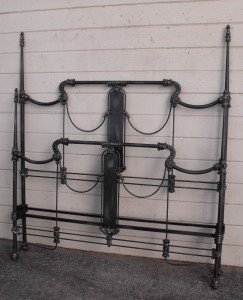This was not a new idea – the Romans used beds, which they could fold and carry easily – but for some unknown reason the fashion never caught on until the 1851 Great Exhibition. A’ French’ double iron bed from Birmingham was selling at the rate of 400 per week in 1849, and shot up to 5,000 after it was featured at the Exhibition in Hyde Park.
These iron beds could be very grand: at Penrhyn Castle in North Wales an ornate one was prepared for the visit of the Prince of Wales in 1894 can be seen in one of the Keep Bedrooms. For the servants’ rooms, plain single beds were considered more appropriate, as at Lanhydrock in Cornwall. Initially the mattress was laid on stout metal lathes, but the day of the spiral spring was at last approaching. Although carriage makers had been using sprung suspension for two hundred years, bed manufacturers could not follow suit until they found a way of keeping the springs in  place.
place.
These beds were also the enemy of the bed bug. Sleepers were susceptible to the unwelcome attentions of lice, fleas and bugs, but of the three the bug seems to have been the most hated. Cimex lectularius, a blood-sucking insect, first appeared in Britain in the sixteenth century. It particularly enjoyed wooden bedsteads, flattening itself to creep into narrow spaces where it lay in wait to bite the unwary.
Thomas Carlyle, had a particular aversion to bugs, which he often allied with an obsession about the habits of her servants. On returning one day to their London home in Cheyne Walk in Chelsea, Carlyle complained that bugs had got into his classic poster bed. Jane duly checked:I proceed to toss over his pillows and blankets with a certain sense of injury! But, on a sudden, I paused in my operations; I stooped to look at something the size of a pin point; a cold shudder ran over me; as sure as I lived it was an infant bug! And, oh heaven, that bug, little as it was, must have parents – grandfathers and grandmothers, perhaps!
The maidservant pointed out that bugs were inevitable in London and that in light of the implied criticism of her cleaning habits she intended to give notice, so that Jane Carlyle bemoaned returning to ‘a house full of bugs and evil passions’.
Bugs doubtless flourished because mattresses were often filled with dirty feathers and rubbish. So although manufacturers of iron beds proclaimed that their products were responsible for the diminution of the ubiquitous nuisance, thanks must also be laid at the feet of the cotton coverings which replaced wool for- mattresses and bolsters. The washable cotton enabled the bugs to be exterminated by boiling.
Canopy beds not only did what all iron beds professed to do for their occupants, but also, when used properly, held in the heat from the people using the bed and protected them from falling debris and rodents and their droppings from above in the rafters.
So why “Four Poster”……..not canopy . Purely a design element that was found to be popular back in the 1800’s , with people that liked the visual effect of four posts going higher, as did their predecessor the canopy bed. But many homes couldn’t accommodate complete canopy beds because of ceiling heights. Four Poster styles gave an impressive tall look for those that weren’t able to fit a canopy into their bedroom.
I hope you’ve found this blog informative . I invite you to revisit my website
to answer any and all questions you might have about antique iron beds.
I also invite you to take a look at our company Face Book page for multiple photo albums on Custom Finishes, Canopy Conversions and a comprehensive “Before & After” King Conversions album.
Cathouse Antique Iron Be#B1BE56







